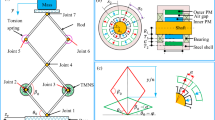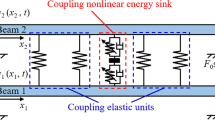Abstract
This work presents the model of a shear-frame-type structure composed of six flexible beams and three rigid masses. Fixed on the ground, outside the structure, two voltage-controlled electromagnetic actuators are used for vibration control. To model the flexible beams, unidimensional finite elements were used. Nonlinear equations for the actuator electromagnetic force, noise in the position sensor, time delays for the control signal update and voltage saturation were also considered in the model. For controlling purposes, a discrete linear quadratic regulator combined with a predictive full-order discrete linear observer was employed. Results of numerical simulations, where the structure is submitted to an impulsive disturbance force and to a harmonic force, show that the oscillations can be significantly reduced with the use of the electromagnetic actuators.









Similar content being viewed by others
Abbreviations
- A :
-
State matrix of the continuous state-space equations
- a :
-
Air gap cross section
- B :
-
Input matrix of the continuous state-space equations
- C :
-
Output matrix of the state-space equations
- c :
-
Control vector
- f :
-
Force vector
- G :
-
State matrix of the discrete state-space equations
- H :
-
Input matrix of the discrete state-space equations
- I :
-
Identity matrix
- i :
-
Total electric current in one actuator
- \(i_{{a_{1} }}\) :
-
Total electric current in actuator 1
- \(i_{{a_{2} }}\) :
-
Total electric current in actuator 2
- K n :
-
Beam element stiffness matrix
- l a :
-
Length of the flexible beams between the ground and m 1
- l b :
-
Length of the flexible beams between m 1 and m 2
- l c :
-
Length of the flexible beams between m 2 and m 3
- l n :
-
Length of a beam element
- M n :
-
Beam element mass matrix
- N :
-
Number of turns of the electromagnetic actuator coil
- P :
-
Solution matrix of the algebraic Riccati equation
- q :
-
Vector of state variables
- \({\hat{\mathbf{q}}}\) :
-
Vector of estimated state variables
- r :
-
Actuator electric resistance
- s :
-
Distance between the actuator surface and the ferromagnetic mass surface
- \(s_{{a_{1} }}\) :
-
Distance between actuator 1 surface and m 1 left surface
- \(s_{{a_{2} }}\) :
-
Distance between actuator 2 surface and m 1 right surface
- t :
-
Continuous time
- \(U_{{a_{1} }}\) :
-
Total voltage in actuator 1
- \(U_{{a_{2} }}\) :
-
Total voltage in actuator 2
- u G :
-
Structure displacement vector
- v G :
-
Structure velocity vector
References
Abreu GLCM, Conceição SM, Lopes V Jr, Brennan MJ, Alves MTS (2012) System identification and active vibration control of a flexible structure. J Braz Soc Mech Sci Eng 34:386–392 Special Issue
Abreu GLCM, Melo GP, Lopes V Jr, Brennan MJ (2015) Active modal damping control of a smart truss structure using a self-organizing fuzzy controller. J Braz Soc Mech Sci Eng 37:441–450
Aly AM (2013) Vibration control of buildings using magnetorheological damper: a new control algorithm. J Eng 2013:1–11
Boletis AR (2005) High speed micromotor on a three axis active magnetic bearing. Thesis. École Polytechnique Fédérale de Lausanne
Bosse A, Lim TW, Shelley S (2000) Modal filters and neural networks for adaptive vibration control. J Vib Control 6:631–648
Butcher JC (2008) Numerical methods for ordinary differential equations, 2nd edn. John Wiley & Sons, West Sussex
Carvalhal R, da Silva S, Lopes Jr V (2004) Modal control applications in intelligent truss structures. In: ABCM symposium series in mechatronics, vol 1, pp 304–310
Carvalhal R, Lopes V Jr, Brennan MJ (2007) An efficient modal control strategy for the active vibration control of a truss structure. Shock Vib 14:393–406
Dolce M, Cardone D, Marnetto R (2000) Implementation and testing of passive control devices based on memory alloys. Earthq Eng Struct Dyn 29:945–968
Ebrahimpour A, Sack RL (2005) A review of vibration serviceability criteria for floor structures. Comput Struct 83:2488–2494
Fung RF, Liu YT, Wang CC (2005) Dynamic model of an electromagnetic actuator for vibration control of a cantilever beam with tip mass. J Sound Vib 288:957–980
Ha QP, Nguyen MT, Li J, Kwok NM (2013) Smart structures with current-driven MR dampers: modeling and second-order sliding mode control. IEEE/ASME Trans Mechatron 18:1702–1712
Hanagan LM, Murray TM, Premaratne K (2003) Controlling floor vibration with active and passive devices. Shock and Vib Dig 35(5):347–365
Harris AF (2003) Active vibration absorbers for control of structural vibration. Dissertation, Faculty of the Virginia Polytechnic Institute and State University
Inman DJ (2001) Engineering vibrations, 2nd edn. Prentice Hall, New Jersey
Juang JN (1984) Optimal design of a passive vibration absorber for a truss beam. J Guid Control Dyn 7(6):733–739
Mahfoud J, Hagopian JD (2011) Fuzzy active control of flexible structures by using electromagnetic actuators. J Aerosp Eng 24:329–337
Nandi A, Neogy S, Irretier H (2009) Vibration control of a structure and a rotor using one-sided magnetic actuator and a digital proportional-derivative control. J Vib Control 15(2):163–181
Occhiuzzi A, Spizzuoco M (2003) Experimental analysis of magnetorheological dampers for structural control. Smart Mater Struct 12:703–711
Ogata K (1995) Discrete-time control systems, 2nd edn. Prentice-Hall, New Jersey
Ogata K (2010) Modern control engineering, 5th edn. Prentice-Hall, New Jersey
Palomera-Arias R (2005) Passive electromagnetic damping device for motion control of building structures. Thesis. Massachusetts Institute of Technology
Preumont A (2011) Vibration control of active structures, an introduction, 3rd edn. Springer, Berlin
Rao SS (2011) Mechanical vibrations, 5th edn. Prentice Hall, New Jersey
Santos HFL, Trindade MA (2011) Structural vibration control using extension and shear active–passive piezoelectric networks including sensitivity to electrical uncertainties. J Braz Soc Mech Sci Eng 33(3):287–301
Schweitzer G, Bleuler H, Traxler A (1994) Active magnetic bearings. vdf Hochschulverlag, Zürich
Steffen V Jr, Rade DA, Inman DJ (2000) Using passive techniques for vibration damping in mechanical systems. J Braz Soc Mech Sci Eng 22(3):411–421
Stephan RM, Pinto FC, Gomes ACDN, Santisteban JA, Salazar AO (2013) Mancais Magnéticos: Mecatrônica sem Atrito. Editora Ciência Moderna, Rio de Janeiro
Tonoli A, Amati N, Silvagni M (2010) Electromechanical dampers for vibration control of structures and rotors. In: Vibration control, pp 1–32
Tripathi PK, Gangadharan KV (2012) Coil based electromagnetic semi-active vibration control for flexible structures. Ann Fac Eng Hundeoara Int J Eng 2:185–190
Vianna FAC, Steffen V Jr (2006) Multimodal vibration damping through piezoelectric patches and optimal resonant shunt circuits. J Braz Soc Mech Sci Eng 28(3):293–310
Wang L, Chen HH, He XD (2011) Active H∞ control of the vibration of an axially moving cantilever beam by magnetic force. Mech Syst Signal Process 25:2863–2878
Wilson CMD, Abdullah MM (2010) Structural vibration reduction using self-tuning fuzzy control of magnetorheological dampers. Bull Earthq Eng 8:1037–1054
Zivanovic S, Pavic A, Reynolds P (2005) Vibration serviceability of footbridges under human-induced excitation: a literature review. J Sound Vib 279:1–74
Author information
Authors and Affiliations
Corresponding author
Additional information
Technical Editor: Kátia Lucchesi Cavalca Dedini.
Appendix: matrices elements
Appendix: matrices elements
Below, all the terms that are different to zero from the global stiffness matrix K G , the global mass matrix M G (including m 1, m 2 and m 3) and the state matrix A are given.
Rights and permissions
About this article
Cite this article
Gruzman, M., Santos, I.F. Vibration control of a flexible structure with electromagnetic actuators. J Braz. Soc. Mech. Sci. Eng. 38, 1131–1142 (2016). https://doi.org/10.1007/s40430-015-0438-x
Received:
Accepted:
Published:
Issue Date:
DOI: https://doi.org/10.1007/s40430-015-0438-x




